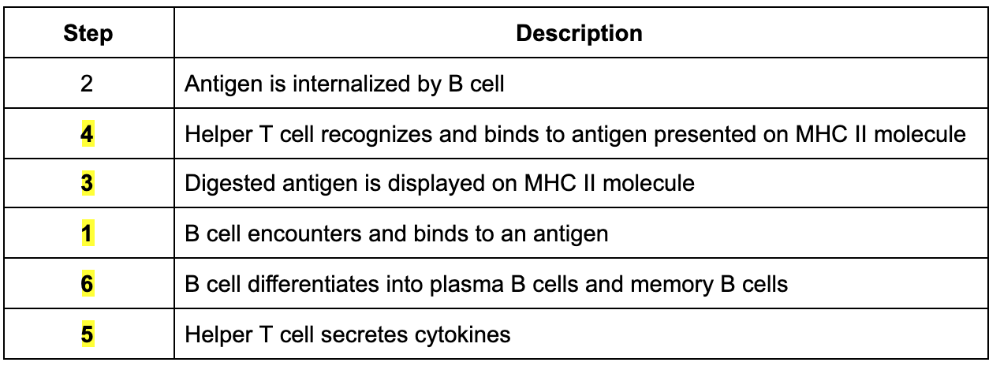The most frequently used portal of entry for pathogens is the
- skin
- parental route
- mucous membrane
- All of these portals are used equally
mucous membrane
The ability of some microbes such as Trypanosoma or Giardia to alter their surface molecules and evade destruction by the host's antibodies is called
- cytopathic effect
- antigenic variation
- virulence
- cytocidal effect
- lysogenic conversion
antigenic variation
Siderophores are bacterial proteins that complete with the host's
- receptors
- red blood cells
- white blood cells
- iron-transport proteins
- antibodies
iron-transport proteins
Bacterium - ID50
E.coli O157:H7 - 20
Legionella pneumophilia - 1
Shigella - 10
Treponema pallidum - 57
Which organism in Table 15.2 most easily causes an infection?
- Shigella
- E.coli O157:H7
- Treponema pallidum
- Legionella pneumophilia
- The answer cannot be determined based on the information provided
Legionella pneumophila
All of the following are used by bacteria to attach to host cells EXCEPT
- A-B toxins
- fimbriae
- M protein
- ligands
- capsules
A-B toxins
Bacteria such as E.coli and Salmonella produce invasins that bind host cells, thus causing the cells to
- release TNF
- destroy the bacteria
- engulf the bacteria
- produce iron-binding proteins
- release cytokines
engulf the bacteria
The best descriptions of direct damage by a pathogen is
- poisonous substances secreted by viruses kill cells
- host cells destroyed when pathogens metabolize and multiply
- protein synthesis is interrupted by toxins
- capsule components of pathogen kill cells
- superantigens cause cytokine release which then cause symptoms of disease
host cells destroyed when pathogens metabolize and multiply
Many pathogens use the same portal for entry and exit from the body
- True
- False
True
For each of the following statements, select whether the statement BEST applies to exotoxins or endotoxins.
- Lipid portions of the outer membrane in gram-negative bacteria -
- Superantigens are a type of -
- Low LD50 -
- Can trigger low blood pressure and fever -
- Endotoxin
- Exotoxin
- Exotoxin
- Endotoxin
All of the following are examples of entry via the parenteral route EXCEPT
- surgery
- bite
- injection
- skin cute
- ingestion
ingestion
Superantigens produce intense immune responses by stimulating lymphocytes to produce
- exotoxins
- cytokines
- interferons
- leukocidins
- endotoxins
cytokines
Lysogenic bacteriophages contribute to bacterial virulence because bacteriophages
- kill the bacteria, causing the release of endotoxins
- produce toxins
- carry plasmids
- give new gene sequences to the host bacteria
- kill human cells
give new gene sequences to the host bacteria
Polio is transmitted by ingestion of water contaminated with feces containing the polio virus. What portal of entry does the polio virus use?
- skin, parenteral and mucous membranes
- parenteral only
- skin and parenteral
- mucous membranes only
- skin only
mucous membranes only
Most pathogens that gain access through the skin
- enter through hair follicles and sweat ducts
- must adhere first while their invasive factors allow them to penetrate
- must be injected
- just infect the skin itself
- can penetrate intact skin
enter through hair follicles and sweat ducts
Antibiotics can lead to septic shock if used to treat
- viral infections
- Gram-positive bacterial infections
- protozoan infections
- gram-negative bacterial infections
- helminth infestations
gram-negative bacterial infections
Which of the following is NOT a cytopathic effect of viruses?
- toxin production
- inclusion bodies forming in the cytoplasm or nucleus
- cell death
- host cells fusing to form multinucleated syncytia
- increased cell growth
toxin production

The table shows the ID50 for Staphylococcus aureus in wounds with and without the administration of ampicillin before surgery. Based on the data, the administration of ampicillin before surgery
- decrease the risk of staphylococcal infection
- has no effect on risk of infection
- increases the risk of staphylococcal infection
- replaces tetracycline
- The answer cannot be determined based on the information provided
decreases the risk of staohylococcal infection
Patients developed inflammation a few hours following eye surgery. Instruments and solutions were sterile, and the Limulus assay was positive. The patients' inflammation was due to
- bacterial infection
- exotoxin
- endotoxin
- viral infection
- The answer cannot be determined based on the information provided
endotoxin
Match each of the following virulence factor with its effect
- Capsules -
- M protein -
- Coagulase -
- Ligands -
- Evade phagocytosis
- Evade phagocytosis
- Forms fibrinogen clots
- Adhere to host cells
A commensal bacterium
- does not receive any benefit from its host
- isn't capable of causing disease in its host
- is beneficial to its host
- may become an opportunistic pathogen
- always cause disease in its host
may become an opportunistic pathogen
The rise in herd immunity amongst a population can be directly attributed to
- None of the answers is correct
- vaccinations
- antibiotic-resistant microorganisms
- improved handwashing
- increased use of antibiotics
vaccinations
Which one of the following does NOT contribute to the incidence of healthcare-associated infections?
- antibiotic resistance
- lapse in aseptic techniques
- gram-negative cell walls
- lack of disinfecting surfaces
- lack of handwriting
gram-negative cell walls
Which of the following is NOT a communicable disease?
- AIDS
- typhoid fever
- tuberculosis
- tetanus
- malaria
tetanus
Which of the following is a fomite?
- droplets from a sneeze
- pus
- insects
- water
- a hypodermic needle
a hypodermic needle
Which of the following statements about biological transmission is FALSE?
- The pathogen may be injected by the bite of the vector
- The pathogen reproduces in the vector
- The pathogen may require the vector as a host
- The pathogen may enter the host in the vector's feces
- Houseflies are an important vector for biological transmission
Houseflies are an important vector for biological transmission
Symptoms of disease differ from signs of disease in that symptoms
- are changes felt by the patient
- are specific for a particular disease
- are changes observed by the physician
- always occur as part of a syndrome
are changes felt by the patient
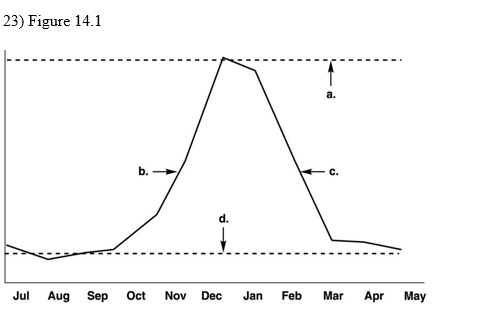
Shows the incidence of influenza during a typical year in the northern hemisphere. Which letter on the graph indicates the endemic level?
- a
- b
- c
- d
d

Which level indicates the gradual end of the epidemic outbreak?
- c
- d
- b
- a
c
A healthcare-associated infection (traditionally known as a nosocomial infection) is
- always caused by pathogenic bacteria
- always caused by medical personnel
- only a result of surgery
- always present, but is inapparent at the time of hospitalization
- acquired during the course of hospitalization
acquired during the course of hospitalization
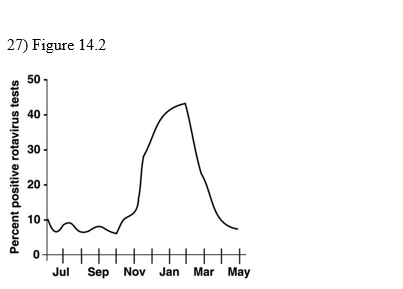
When is the prevalence the highest?
- February
- January
- July
- March
February
A disease in which the causative agent remains inactive for a time before producing symptoms is referred to as
- subacute
- latent
- subclinical
- acute
- zoonotic
latent
In which of the following diseases can gender be considered a viable predisposing factor?
- salmonellosis
- anthrax
- urinary tract infections
- pneumonia
- tetanus
urinary tract infections
The major significance of Robert Koch's work is that
- microorganisms cause disease
- diseases can be transmitted from one animal to another
- microorganisms can be cultured
- microorganisms are present in a diseased animal
- microorganisms are the result of disease
microorganisms cause disease
The yeast Candida albicans does NOT normally cause disease because of
- parasitic bacteria
- commensal bacteria
- other fungi
- symbiotic bacteria
- mutualistic bacteria
mutualistic bacteria
If a prodromal period exists for a certain disease , it should occur prior to
- decline
- incubation
- convalescence
- illness
illness
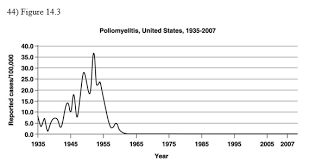
The graph shows the incidence of polio in the United States. The period 1945 and 1955 indicates a(n)
- epidemic level
- communicable disease
- sporadic infection
- pandemic
- endemic level
epidemic level

Interpreting this graph, can we conclude that polio has been eradicated globally? Why or why not?
- No, because the graph only depicts incidence of polio in the United States
- No, because polio is part of the normal microbiota, and could become resurgent if vaccination efforts lapse
- Yes, because a zero incidence rate for over 40 years clearly indicates there are no longer any susceptibles left in the global population
- Yes, as the number of reported cases goes to zero around 1965
No, because the graph only depicts incidence of polio in the United States
Which of the following diseases is NOT spread by droplet infection?
- HIV
- measels
- diphtheria
- tuberculosis
- the common cold
HIV
Biological transmission differs from mechanical transmission in that biological transmission
- involves reproduction of a pathogen in an arthropod vector prior to transmission
- works only with noncommunicable disease
- requires direct contact
- involves fomites
- occurs when a pathogen is carried on the feet of an insect
involves reproduction of a pathogen in an arthropod vector prior to transmission
Focal infections initially start out as
- septicemia
- sepsis
- local infections
- bacteremia
- systemic infections
local infections
Which of the following statements about the human microbiome is false?
- The relationship between a person and their normal microbiota can be categorized as parasitism
- A person's microbiome begins to be established at birth
- The normal microbiota can produce substances that keep out pathogenic microbes
- The composition of the microbiome can change over the course of a person's lifetime
- Babies born vaginally may have a different microbiome than babies born via C-section
The relationship between a person and their normal microbiota can be categorized as parasitism
The etiologic agent of COVID-19 is bacterium
- True
- False
False
Match the following terms with the correct definition
- Communicable disease -
- Contagious disease -
- Endemic disease -
- Pandemic disease -
- Acute disease -
- A disease that can be spread from
- A communicable disease that is
- A disease that is always present
- A disease that is present as an e
- A disease where symptoms develope
Match the following terms with the BEST example
- endemic disease -
- syndrome -
- pandemic disease -
- acute disease -
- secondary infection -
- malaria in some regions of Africa
- irritable bowel syndrome
- COVID-19
- the common cold
- pneumonia
Which of the following might violate (go against) Koch's postulates?
- Some cattle that died of anthrax had the pathogen Bacillus anthracis while others did not
- When the healthy cow that contracted anthrax and died of anthrax was examined, Bacillus anthracis was found in its bloodstream
- When the lab-cultured Bacillus anthracis was inculated into a healthy cow, the cow contracted anthrax
- Bacillus anthracis was grown in pure culture in the lab
Some cattle that died of anthrax had the pathogen Bacillus anthracis while others did not.
Innate immunity
- is slower than adaptive immunity in responding to pathogens
- is nonspecific and present at birth
- involves a memory component
- inloves T cells and B cells
- provides increased susceptibility to disease
is nonspecific and present at birth
Innate immunity includes all of the following except
- production of antibody
- phagocytosis
- production of interferon
- inflammation
- activation of complement
production of antibody
All of the following protect the skin and mucous membranes from infection except
- the "cillary escalator"
- tears
- multiple layers of cells
- hydrochloric acid
- saliva
hydrochloric acid
All of the following increase blood vessels permeability except
- kinins
- lysozymes
- leukotrienes
- histamine
- prostaglandins
lysozymes
A child falls and suffers a deep cut on her leg. The cut went through her skinn and she is bleeding. Which of the following defense mechanisms will participate in eliminating contaminating microbes?
- normal skin flora
- mucociliary escalator
- phagocytosis in the inflammatory response
- acidic skin secretions
- lysozyme
phagocytosis in the inflammatory response
Which of the following is mismatched?
- pus- tissue debris and dead phagocytes in a white or yellow fluid
- diapedesis - movement of leukocytes between capillary walls cells out of blood and into tissue
- abscess - a cavity created by tissue damage and filled with pus
- chemotaxis - chemical degradation inside a phagolysosome
- scab - dried blood clot over injured tissue
chemotaxis - chemical degradation inside a phagolysosome
A chill is a sign that
- the metabolic rate is decreasing
- blood vessels are dilating
- body temperature is not changing
- body temperature is rising
- body temperature is falling
body temperature is rising
Normal microbiota provide protection from infection in each of the following ways except
- they make the chemical environment unsuitable for nonresident bateria
- they produce lysozyme
- they compete with pathogens for nutrients
- they produce antibacterial chemicals
- they change the pH of the environment
they produce lysozyme
Each of the following is an effect of complement activation except
- increased phagocytic activity
- increased blood vessel permeability
- bacterial cell lysis
- interference with viral replication
- opsonization
interference with viral replication
Which of the following is involved in resistance to parasitic helminths?
- basophils
- eosinophils
- monocytes
- lymphocytes
- neutrophils
eosinophils
Which non-specific defense mechanism is mismatched with its associated body structure or body fluid?
- lacrimal apparatus - eye
- mucocillary escalator - intestines
- keratin and tightly packed cells - skin
- very acidic pH - stomach
- lysozyme - tears and saliva
mucocillary escalator - intestines
Lysozyme and the antibiotic penicillin have similar mechanisms of action in that they both cause damge to the bacterial
- cell membrane
- capsule
- ribosomes
- cell wall
- DNA
cell wall
All of the following are iron-binding proteins found in humans except
- lactoferrin
- ferritin
- siderophorin
- transferrin
siderophorin
Please match the following terms with the correct description
- margination -
- alpha and beta-interferons -
- ciliary escalator -
- opsonization -
- cytokines -
- gathering of phagocytic white blood
- stimulates unifected cells to produce antiviral proteind
- propels trapped microorganisms away from the lungs
- increases adherence of phagocy
- signals the hypothalamus to pro
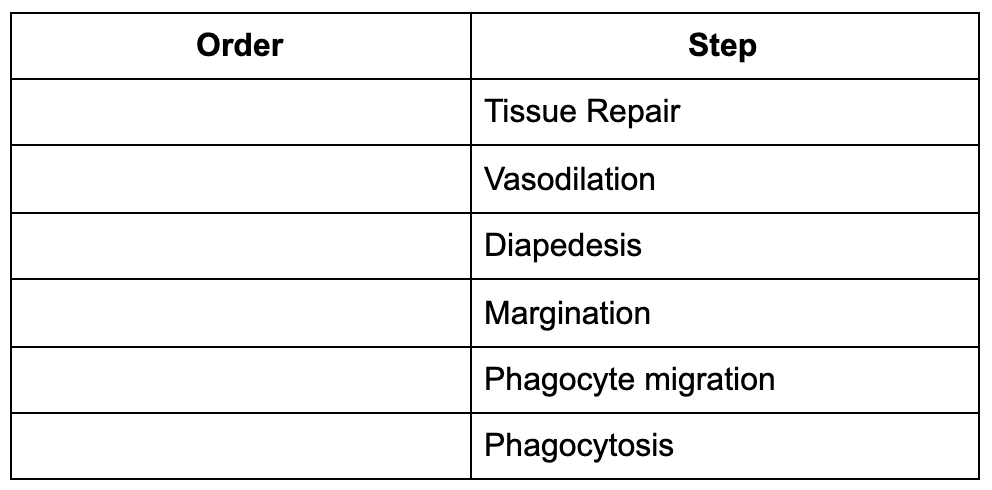
Place the steps in the right order. Fill in the blanks with numbers 1-6.
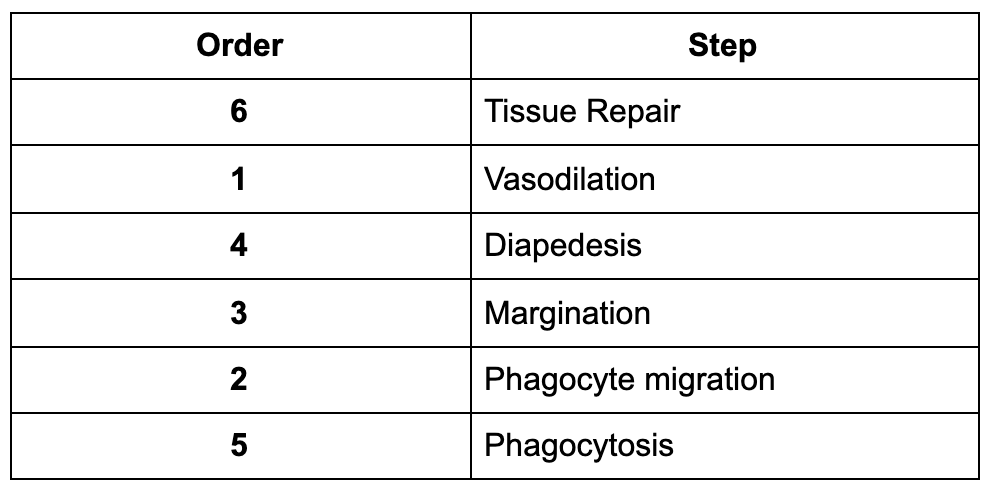
An abnormally high body temperature is called a ________.
- hypothermia
- fever
- cytokine storm
- shock response
fever
Which of the following is an effect of opsonization?
- cytolysis
- increased diapedesis of phagocytes
- inflammation
- increased adherence of phagocytes to microorganisms
- increased margiation of phagocytes
increased adherence of phagocyres to microorganisms
All of the following protect the skin and mucous membranes from infection except
- multiple layers of cells
- the "ciliary escalator"
- saliva
- HCI
- tears
HCI
All of the following are effects of kinins except
- drawing in neutrophils to infected or injure area
- increased blood vessels permeability
- chemotaxis of phagocytic granulocytes
- production of antibodies
- vasodilation
production of antibodies
Which non-specific defense mechanism is mismatched with its associated body structure or body fluid?
- cilary escalator - intestines
- very acidic pH - stomach
- cerumen and sebum - ear
- lysozyme - tears and saliva
- keratin and tightly packed cells - skin
cilary escalator - intestines
TLRs attach to all of the following except
- PAMPs
- lipopolysaccharide outer membrane
- antimicrobial peptides
- flagellin
- peptidogylcan
antimicrobial peptides
Match the following leukocytes with the correct description
- Monocytes -
- Lymphocytes -
- Basophils -
- Eosinophils -
- Mature into phagocytic macrop
- Play a role in adaptive immunity
- Play a role in allergic responses
- Target parasites and helminths
The body has two circulatory systems, the lymphatic system and the blood circulatory system
- True
- False
True
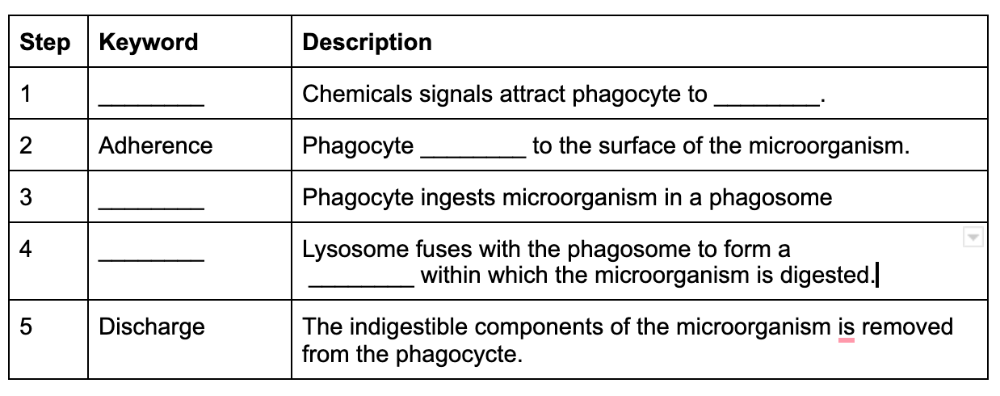
Fill in the following table with the information about phagocytosis
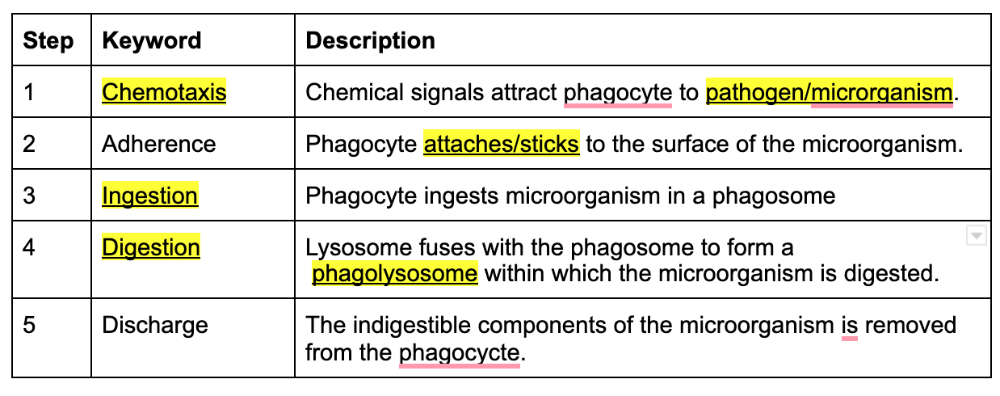
Which of the following is the best definition of epitope?
- specfic regions on antigens that interact with MHC class molecules
- specific regions on antigens that interact with antibodies
- specific regions on antigens that interact with haptens
- specific regions on antigens that interact with perforins
- specific regions on antigens that interact with T-cell receptors
specific regions on antigens that interact with antibodies
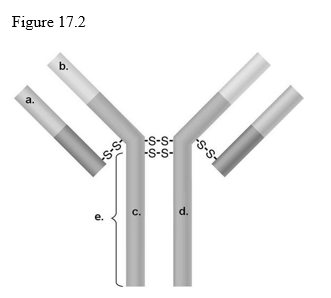
Which areas are different for all IgM antibodies?
- c and d
- b and c
- a and c
- a nd b
a and b
Which of the follwoing is the best defintion of antigen?
- a pathogen
- a chemical taht elicts an antibody response and can combine with these antibodies
- a chemical that combines with antibodies
- a protein that combines with antibodies
- something foreign in the body
a chemical that elicts an antibody response and can combine with these antibodies
Which of the following statements is NOT a possible outcome of antigen-antibody reaction?
- neutralization
- opsonization
- agglutination
- clonal deletion
- activation of complement
clonal deletion
When an antibody binds to a toxin, the resulting action is referred to as
- opsonization
- agglutination
- neutralization
- apoptosis
neutralization
Which of the following recognizes antigens displayed on host cells with MHC II?
- basophil
- TH cell
- natural killer cell
- TC cell
- B cell
TH cell
Which of the following destroys virus-infected cells?
- TH
- CTL
- B cells
- T reg
- dendritic cells
CTL
The specificity of an antibody is due to
- the H chains
- the constant portions of the H and L chains
- its valence
- the variable portions of the H and L chains
- the L chains
the variable portions of the H and L chains
Which one of the following causes transmembrane channels in target cells?
- IL-1
- IL-2
- granzymes
- hapten
- perforin
perforin
Which of the following is NOT a characteristic of B cells?
- They have antibodies on their surfaces
- They recognize antigens associated with MHC I.
- They originate in bone marrow.
- They are responsible for the memory response.
- They are responsible for antibody formation.
They recognize antigens associated with MHC I.
Which of the following is NOT a characteristic of cellular immunity?
- Response to abnormal cells
- The cells originate in bone marrow
- Cells mature in the thymus gland
- B cells make antibodies
- T cells interact with epitiopes in MHC molecules
B cells make antibodies

Which areas are similar for all IgG antibodies?
- a and c
- b and c
- a and b
- c and d
- b an d
c and d
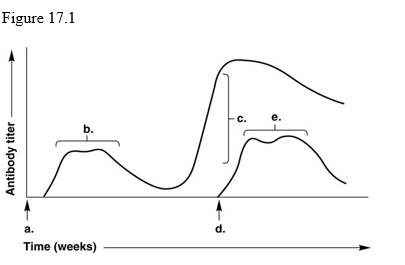
Which letter on the graph indicates the patient's secondary response to a repeated exposure with the identical antigen?
- b
- c
- a
- d
c
Which of the following is not a professional antigen-presenting cell?
- T cells
- Dendritic cells
- B cells
- Macrophages
T cells
Which of the following recognizes antigens displayed on host cells with MHC II?
- natural killer cell
- Cytotoxin T cell
- Helper T cell
- basophil
- regulatory T cell
Helper T cell
ADCC is a process that is most effective in destroying
- bacterial toxins
- eukaryotic pathogens
- extracellular viruses
- prions
- bacterial pathogens
eukaryotic pathogens
Which of the following WBCs are not lymphocytes?
- macrophages
- helper t cells
- NK cells
- B cells
- cytotoxic t cells
macrophages
Which of the following is involved in ensuring that a mother's antibodies do not react against her fetus?
- Helper T cells
- Cytotoxic T lymphocytes
- Treg cells
- Antigen presenting cells
Treg cells
Which of the following is the best definition of antigen?
- a molecule that can bind to antibodies and cause more antibodies to be produced
- something foreign in the body
- a pathogen
- a virus
- a protein that combines with antibodies
a molecule that can bind to antibodies to be produced
Please match the type of immunity with correct example
- Naturally acquired active immunity -
- Naturally acquired passive immunity -
- Artificially acquired active immunity -
- Artificially acquired passive immunity
- Recovery from mumps
- A baby receives antibodies from
- Vaccination
- A susceptible individual recieving
PLease match each of the following descriptions to the right class of antibodies
- Large antibodies that cause agglutination of pathogens
- Found in mucus, tears and saliva
- Respond and bind to parasitic worms
- First to respond to an infection
- Able to cross the placenta
- IgM
- IgA
- IgE
- IgM
- IgG
The secondary immune response takes longer to be activated compared to primary immune response.
- True
- False
False
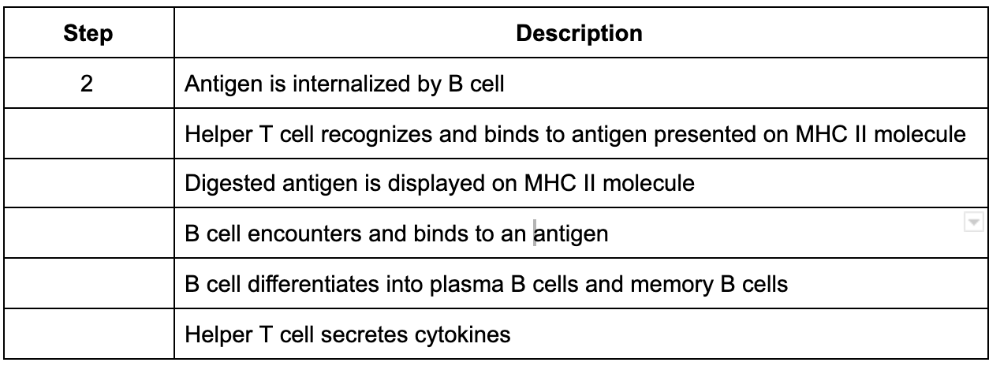
Arrange the following steps of B cell activation in the right order.
